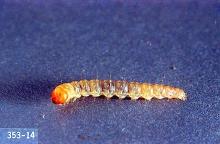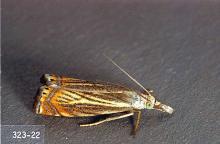Chrysoteuchia topiaria
Pest description and crop damage Larvae overwinter in cocoons in plant duff. Adult moths appear in May, June, and July. Larvae reach 0.5 inch long and are dirty white with a brown head. They feed on stems and runners beneath plant duff. Feeding may kill all or part of the plant. In Oregon, damage from larval feeding is first observed in late August and September. If beds are weedy, especially grassy, girdlers will be able to establish themselves before they move to cranberries. Newly hatched larvae like to burrow into the crowns of grass plants and feed.
Sampling and thresholds Pheromone traps are available to monitor flight activity of the moth stage. Scout for larvae in weedy areas or areas of weak vine growth during early to midsummer. In late summer, look for frass in the duff next to cranberry stems.
Management-cultural control
- Re-sanding the cranberry bed reduces populations of the cranberry girdler (they prefer plant duff) and also enhances insecticidal control. Apply 0.5 to 0.75 inch of sand in fall or winter when cold weather has firmed the bed. Short floods (1 or 2 days) in August after egg hatch have controlled small larvae; flooding more than 2 days may damage vines. A long flood (1+ month) during the dormant season may also help control girdler.
Management-biological control
- parasitic nematodes-Apply to soil 2 to 4 weeks after pheromone traps indicate peak moth flight. See label for rate (generally 2 to 3 billion/A), timing, and irrigation requirements. Cranberry bed may be spot-treated with nematodes if areas of larval infestations are properly identified; if spot treating, apply a buffer area of about 20 ft around each infested area of the bed. Plan ahead-these are the optimal treatment and they can be in short supply.
Management-chemical control: COMMERCIAL USE
There are currently no efficacious products for girdler control.



